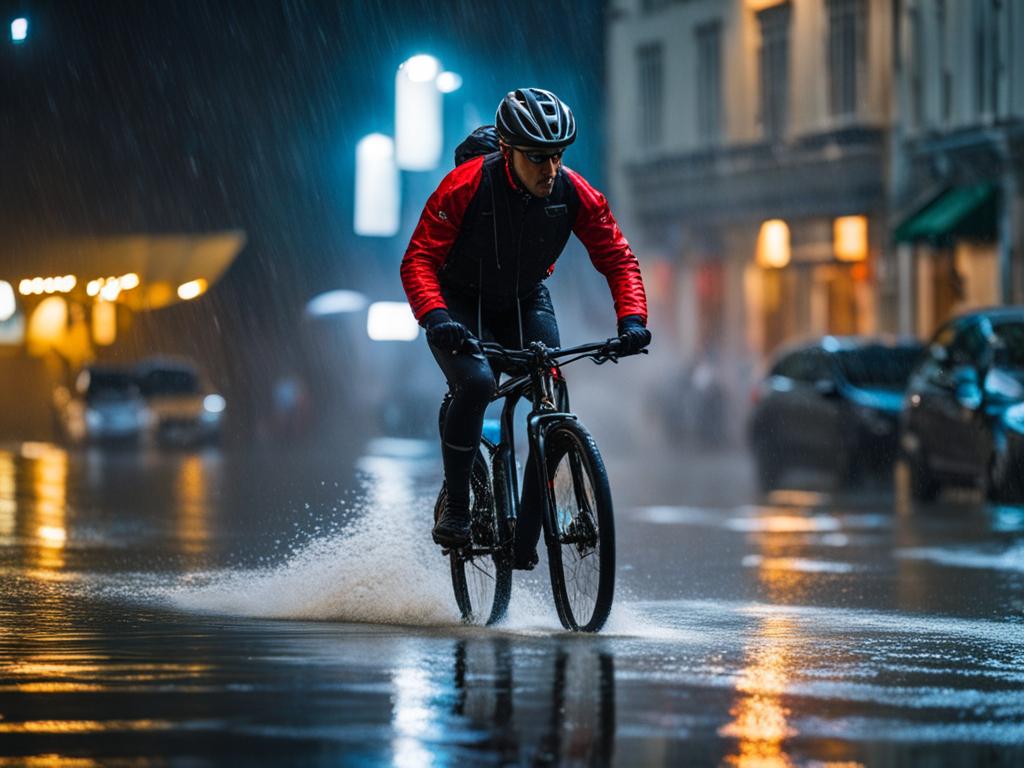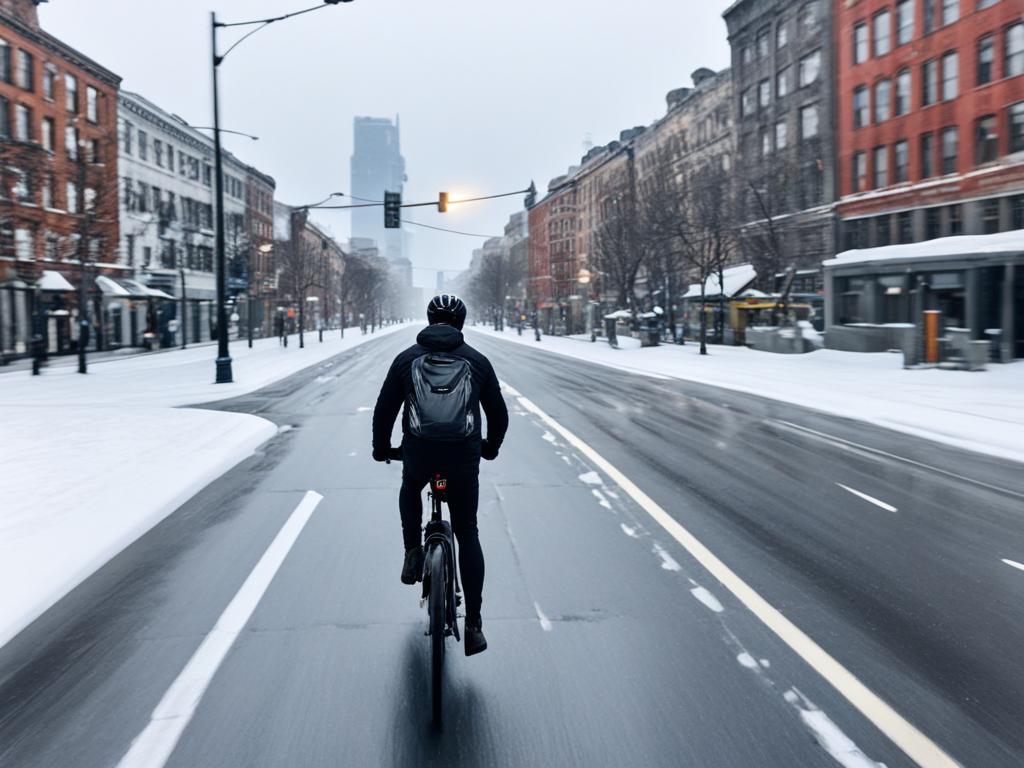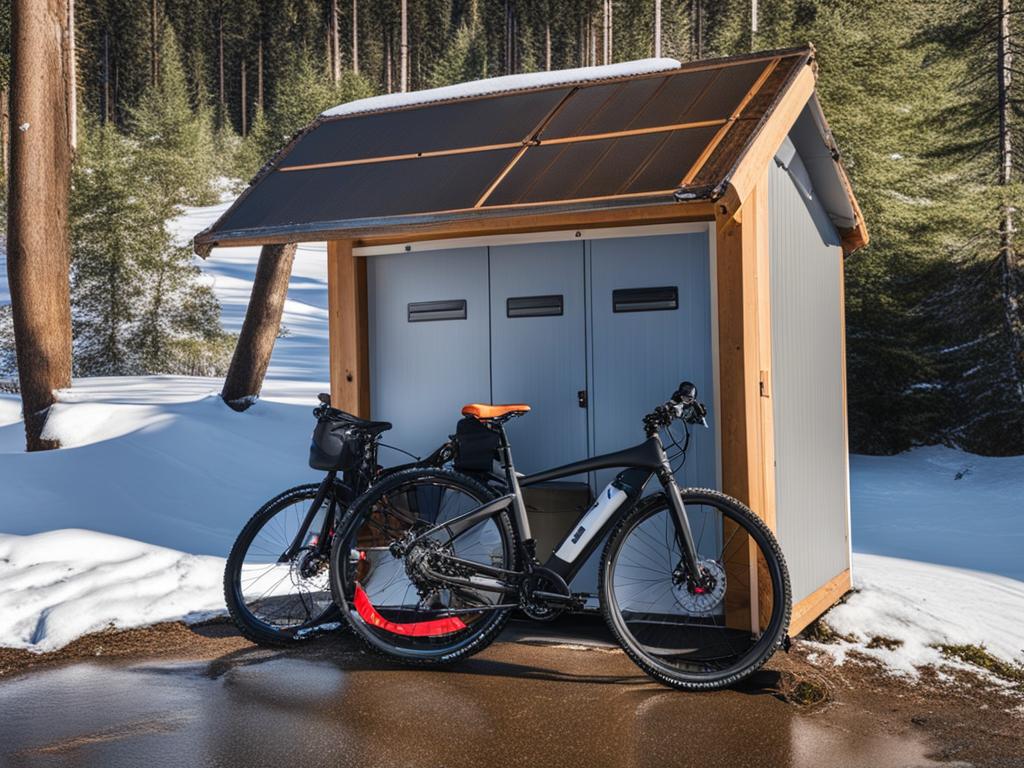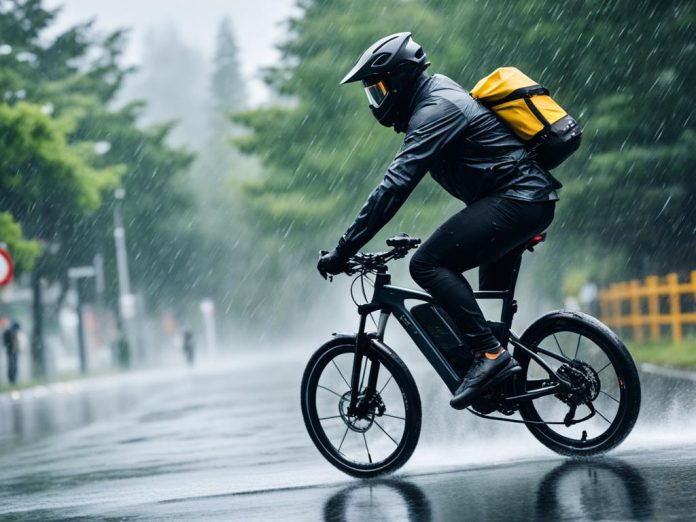Weather conditions and e-bike safety can have a significant impact on the performance of your e-bike. Riders need to understand how different weather conditions can affect their e-bike and take necessary precautions. In this article, we will discuss the effects of weather conditions on e-bike performance, provide tips for riding an e-bike in different weather conditions, and offer advice on maintenance and safety measures to ensure optimal performance.
Key Takeaways for Weather conditions and e-bike safety
- Weather conditions affect e-bike performance and safety
- Choose an e-bike suitable for all weather conditions
- Take precautions when riding in different weather conditions
- Maintain your e-bike for optimal performance in all weather conditions
- Follow safety measures for riding in various weather conditions
How Weather Conditions and e-bike safety can Affect E-Bike Performance
When it comes to e-bikes, weather conditions play a crucial role in their performance. Different weather conditions, such as extreme heat, cold, rain, or snow, can have an impact on the overall functionality and efficiency of an e-bike.
Extreme temperatures, for instance, can affect the battery life and efficiency of an e-bike. In extreme heat, the battery may drain faster, leading to shorter rides and reduced overall performance. Conversely, in extreme cold, the battery may experience a decrease in power output, resulting in reduced speed and efficiency.
Wet weather conditions, including rain or snow, can also have significant effects on e-bike performance. These conditions can impact traction and stability, making it more challenging to maintain control on slippery surfaces. Riders need to exercise caution and adjust their riding style accordingly in wet weather conditions.
Choose the Right E-Bike for All Weather Conditions
To ensure optimal performance in various weather conditions, it is crucial to select an e-bike that is specifically designed to handle the challenges posed by different weather elements. Look for e-bikes that offer features such as:
- Waterproof or water-resistant components to protect against moisture damage.
- All-terrain tires with excellent traction for better control on wet or slippery surfaces.
- Reliable disc brakes that provide effective stopping power even in wet conditions.
- High-quality suspension systems for enhanced stability and comfort on uneven terrain.
By choosing an e-bike that is well-equipped to handle various weather conditions, riders can enjoy a safe and reliable riding experience all year round.

| Weather Conditions | Effects on E-Bike Performance |
|---|---|
| Extreme heat | Reduced battery life and efficiency |
| Extreme cold | Decreased power output and reduced speed |
| Rain or snow | Reduced traction and stability |
Tips for Riding an E-Bike in Different Weather
Riding an e-bike in different weather conditions requires certain precautions to ensure safety. Here are some helpful tips to consider:
- Wet or Slippery Conditions: Reduce your speed and avoid sudden maneuvering when riding in wet or slippery conditions. This will help maintain traction and stability on slick surfaces.
- Cold Weather: Dress in layers to stay warm and comfortable while riding in cold weather. Ensure proper visibility by wearing reflective clothing, making you more visible to other road users.
- Hot Weather: Stay hydrated and protect yourself from the sun when riding in hot weather. Drink plenty of water and apply sunscreen to prevent dehydration and sunburn.
- Tire and Brake Maintenance: Regularly check your tires for wear and tear, ensuring they are properly inflated for optimal performance. Additionally, inspect your brakes to ensure they are functioning effectively in all weather conditions.
By following these tips, you can enhance your safety and enjoyment when riding an e-bike in different weather conditions.

Quote:
“When riding in wet or slippery conditions, it is important to reduce speed and avoid sudden maneuvering.”
| Weather Condition | Tips |
|---|---|
| Wet or Slippery | Reduce speed and avoid sudden maneuvering. |
| Cold | Dress in layers and wear reflective clothing. |
| Hot | Stay hydrated and protect yourself from the sun. |
| Tire and Brake Maintenance | Regularly check tires and brakes for optimal performance. |
E-Bike Maintenance for Different Weather Conditions
Maintaining your e-bike is essential for ensuring its longevity and optimal performance, especially when riding in different weather conditions. By following these maintenance tips, you can keep your e-bike in top shape, regardless of the weather.
Routine Cleaning and Lubrication
Regular cleaning and lubrication of the chain and drivetrain are crucial for preventing rust and ensuring smooth operation. Use a mild detergent and water to clean the frame, tires, and components. After cleaning, dry the e-bike thoroughly to prevent water damage. Apply lubricant to the chain, gears, and pivot points to keep them well-lubricated. This will minimize wear and tear caused by weather exposure.
Protecting Your E-Bike in Wet Weather
Riding in wet weather exposes your e-bike to moisture, which can lead to corrosion and other issues. After riding in the rain, wipe down your e-bike to remove any moisture or dirt. Pay special attention to the electrical components, such as the battery and wiring. If you frequently encounter wet weather conditions, consider investing in fenders to protect your bike from splashes and installing waterproof covers for your battery and controller.
Battery Maintenance in Winter
Extreme cold temperatures can negatively affect battery performance. To protect your e-bike’s battery during winter, store it in a temperature-controlled environment whenever possible. If that’s not feasible, wrap the battery with insulation and use a neoprene cover to provide additional protection. Avoid exposing the battery to freezing temperatures for extended periods as it can damage the cells and reduce overall capacity.
Regular Maintenance Checks
Performing regular maintenance checks is vital for keeping your e-bike in optimal condition, regardless of the weather. Check the tire pressure regularly to ensure proper traction and stability. Inspect the brake pads to ensure they are in good condition and provide adequate stopping power. Additionally, examine the frame, cables, and other components for any signs of wear or damage. Address any issues promptly to prevent further damage and ensure safe riding.
By following these maintenance practices, you can ensure that your e-bike performs reliably and lasts longer, regardless of the weather conditions. Stay proactive and attentive to your e-bike’s needs to enjoy a smooth and safe riding experience year-round.

| Weather Condition | Maintenance Tips |
|---|---|
| Wet weather (rain, snow) | – Dry the e-bike thoroughly after riding – Apply a rust inhibitor to prevent corrosion – Use waterproof covers for battery and controller |
| Extreme cold temperatures | – Store the battery in a temperature-controlled environment – Insulate the battery and use a neoprene cover – Avoid exposing the battery to freezing temperatures for long periods |
| Regular maintenance checks | – Check tire pressure regularly – Inspect brake pads for wear – Examine frame and components for any damage – Address issues promptly |
E-Bike Safety Measures for Weather Conditions
Safety should always be a priority when riding an e-bike in different weather conditions. By taking the necessary precautions, you can ensure a safe and enjoyable riding experience, regardless of the weather. Here are some valuable safety measures to keep in mind:
1. Wear Appropriate Safety Gear
Enhance your visibility on the road by wearing safety gear such as a helmet and reflective clothing. These precautions can help other road users spot you more easily, especially in poor weather conditions.
2. Be Mindful of Your Surroundings
Stay alert and aware of your surroundings while riding in different weather conditions. Keep an eye out for potential hazards like slippery surfaces, puddles, or reduced visibility. Adjust your riding behavior accordingly to ensure your safety and the safety of others.
3. Ride at a Safe Speed
When riding an e-bike in inclement weather, it’s crucial to reduce your speed. Wet or icy surfaces can significantly reduce traction and increase the risk of accidents. Always maintain a safe speed that allows you to maintain control of your e-bike.
4. Maintain a Proper Distance
Give yourself ample space and distance from other vehicles while riding in any weather condition. This is particularly important in adverse weather, such as heavy rain or snow, where stopping distances may be increased. Keeping a safe distance ensures you have enough time to react to unexpected situations.
5. Check Weather Forecasts and Plan Ahead
Before heading out on your e-bike, check weather forecasts to anticipate any potential storms or adverse weather conditions. If possible, plan your rides during periods of better weather or avoid riding altogether when conditions are unsafe.
“Remember, your safety is paramount. Don’t hesitate to postpone or cancel your ride if weather conditions pose significant risks.”
| Weather Condition | Safety Measure |
|---|---|
| Rain | Wear waterproof gear and adjust your riding style to account for reduced traction. |
| Snow/Ice | Equip your e-bike with studded tires for better grip and consider riding at a slower pace. |
| Extreme Heat | Stay hydrated, wear lightweight and breathable clothing, and avoid riding during the hottest parts of the day. |
| Strong Winds | Exercise caution and be prepared for stronger gusts that may affect your balance. Adjust your riding position accordingly. |
Best E-Bikes for All Weather Conditions
When it comes to riding an e-bike in all weather conditions, choosing the right bike is essential. To ensure optimal performance and safety, there are specific features and specifications to consider. Look for e-bikes that can withstand various weather conditions with durable frames and components.
E-bikes equipped with high-quality tires and disc brakes offer better traction and stopping power, especially in wet or slippery conditions. These features provide riders with increased control and stability, minimizing the risk of accidents.
Another important factor to consider is the motor and battery of the e-bike. Opt for a powerful motor that can handle various terrains and weather conditions. A long-lasting battery is crucial for reliable performance, allowing you to ride confidently without worrying about running out of power.
To help you make an informed decision, below is a comparison table featuring some of the best e-bikes for all weather conditions:
| E-Bike Model | Frame Material | Tires | Brakes | Motor | Battery Life |
|---|---|---|---|---|---|
| Brand X | Aluminum | All-terrain | Disc brakes | 250W | Up to 60 miles |
| Brand Y | Carbon Fiber | Hybrid | Hydraulic disc brakes | 350W | Up to 80 miles |
| Brand Z | Steel | Mountain | Mechanical disc brakes | 500W | Up to 100 miles |
Remember, choosing the best e-bike for all weather conditions ensures a comfortable, safe, and enjoyable ride. Consider your specific needs, terrain, and weather conditions when making a decision. With the right e-bike, you can confidently navigate diverse weather conditions while experiencing the thrill and freedom of electric biking.
Riding Safely in Extreme Weather Conditions
When it comes to extreme weather conditions, riding an e-bike requires extra caution and preparation. Whether you’re faced with heavy rain, snowstorms, or high winds, ensuring your safety should be a top priority. While it’s advisable to avoid riding in such conditions if possible, sometimes it may be necessary to venture out. Here are some essential tips to help you ride safely in extreme weather:
- Wear Appropriate Protective Gear: Before heading out, make sure you’re dressed in protective gear suitable for the specific weather conditions. This includes wearing a helmet, waterproof clothing, and visibility-enhancing accessories, such as reflective vests or backpack covers.
- Be Aware of Potential Hazards: Extreme weather can create hazardous road conditions. Stay vigilant and watch out for potential hazards such as slippery surfaces, fallen branches, or reduced visibility due to fog or heavy rain. Adjust your riding style accordingly and be prepared to make sudden maneuvers if necessary.
- Check Weather Forecasts: Stay informed about the weather conditions before heading out on your e-bike. Keep track of weather updates and be prepared to alter your riding plans or choose a safer route if conditions worsen unexpectedly.
- Adjust Riding Style: In extreme weather, it’s essential to adapt your riding style to ensure stability and control. Ride at a moderate speed, and avoid sudden acceleration or braking, as this can lead to loss of traction. Maintain a safe distance from other vehicles and anticipate potential hazards.
- Seek Shelter or Assistance: If conditions rapidly deteriorate or become unsafe, prioritize your safety and seek shelter. Find a secure location, such as a nearby building or a bus shelter, until the weather improves. If you encounter severe weather-related difficulties or emergencies, don’t hesitate to call for assistance.
Remember, riding an e-bike in extreme weather conditions requires careful consideration and preparation to ensure a safe experience. Prioritize your safety, be aware of the risks, and make informed decisions when it comes to riding in challenging weather.

Final Thoughts on Weather Conditions and e-Bike Safety
Riding an e-bike in different weather conditions requires awareness, preparation, and adherence to safety measures. By understanding how weather conditions can affect e-bike performance and taking necessary precautions, riders can ensure a safe and enjoyable riding experience in diverse climates.
Regular maintenance is key to keeping your e-bike in optimal condition. By regularly cleaning and lubricating the chain and drivetrain, you can prevent rust and ensure a smooth ride. Additionally, choosing the right e-bike for all weather conditions can contribute to its longevity and performance. Look for e-bikes with durable frames and components that can withstand various weather challenges, and opt for high-quality tires and disc brakes for improved traction and stopping power in wet or slippery conditions.
Remember to prioritize safety at all times. Wear appropriate safety gear, such as a helmet and reflective clothing, to enhance visibility. Adjust your riding behavior according to the weather conditions and ride at a safe speed, maintaining a proper distance from other vehicles. Regularly check the weather forecast before heading out to avoid adverse weather conditions whenever possible.
Overall, with proper awareness, preparation, and adherence to safety measures, you can confidently enjoy riding your e-bike in different weather conditions. Stay informed, stay safe, and enjoy the ride!
FAQ
How do weather conditions affect e-bike performance?
Extreme temperatures can impact the battery life and efficiency of an e-bike, while wet weather conditions can affect traction and stability.
What are some tips for riding an e-bike in different weather?
Reduce speed and avoid sudden maneuvering in wet or slippery conditions. Dress in layers and ensure visibility in cold weather, and stay hydrated and protected from the sun in hot weather.
How should e-bike maintenance be carried out in different weather conditions?
Regular cleaning, lubrication, and drying off after riding are important for preventing rust and water damage. Checking tire pressure and brake pads should also be done regularly.
What safety measures should be taken when riding an e-bike in various weather conditions?
Wear appropriate safety gear, adjust riding behavior according to weather conditions, maintain a safe speed and distance from other vehicles, and stay informed about the weather forecast.
Which e-bikes are best for all weather conditions?
Look for e-bikes with durable frames, high-quality tires, disc brakes, powerful motors, and long-lasting batteries for reliable performance in different weather conditions.
How should e-bike riders approach extreme weather conditions?
It is advisable to avoid riding in extreme weather conditions if possible. If riding is necessary, wear protective gear, enhance visibility, be aware of potential hazards, and adjust riding style accordingly.






